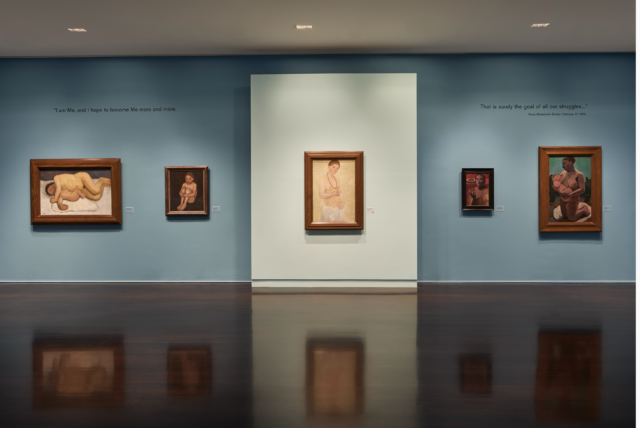
“Paula Modersohn-Becker: Ich bin Ich / I Am Me” is an intimate look at motherhood and identity (photo by Annie Schlechter / courtesy Neue Galerie New York)
ICH BIN ICH / I AM ME
Neue Galerie New York
1048 Fifth Ave. at 86th St.
Wednesday – Sunday through September 9, $15-$28
www.neuegalerie.org
Two of the most powerful shows of the year have featured works primarily about motherhood by two extraordinary, lesser-known artists. In the simply titled “Käthe Kollwitz” at MoMA, paintings, drawings, and sculptures by the Prussian-born artist (1867–1945) focused on motherhood, the female body, and death, with haunting self-portraits, heavily influenced by the loss of one of her sons in WWI.
In “Paula Modersohn-Becker: Ich Bin Ich / I Am Me,” at Neue Galerie through September 9, paintings and drawings by the German artist (1876–1907) center around pregnancy, the female body, and birth, along with what are believed to be the first nude self-portraits by a woman. Tragically, Modersohn-Becker, whose uncle had tried to assassinate King Wilhelm of Prussia in 1861, died at the age of thirty-one of a postpartum embolism, her infant daughter, Mathilde, in her arms, leaving behind a legacy of more than seven hundred paintings and fourteen hundred drawings.
The wonderfully curated exhibition by Jill Lloyd and Jay Clarke includes several quotes from Modersohn-Becker that puts her work in context. “I am more and more convinced that intimacy is the soul of all great art,” she wrote in 1903. In a letter to her close friend Rainer Maria Rilke, she explained, “And now I don’t know how to sign my name. I am not Modersohn and I am not Paula Becker anymore, I am Me, and hope to become that more and more.”
Among the highlights are Self-Portrait with Two Flowers in Her Raised Left Hand, Kneeling Girl with Stork, Girl Blowing a Flute in the Birch Forest, Otto Modersohn Sleeping, and Self-Portrait on Sixth Wedding (Anniversary) Day, the last one depicting the artist topless, a long necklace dangling between her breasts, her right hand above her pregnant belly, her left hand below, as she knowingly looks directly at the viewer.
“I was always very keen to establish Paula Modersohn-Becker’s place in the canons of art history because I think she richly deserves it,” Lloyd says in the above video tour. “We go with her on a kind of journey towards finding herself as an artist, finding herself as a woman, and finding herself as a human being.”
Modersohn-Becker richly deserves this first American museum retrospective, a journey that confirms her status as a key figure in German Expressionism and beyond.
[Mark Rifkin is a Brooklyn-born, Manhattan-based writer and editor; you can follow him on Substack here.]